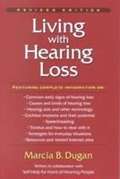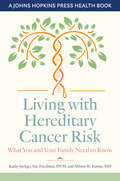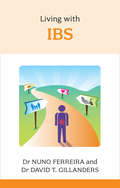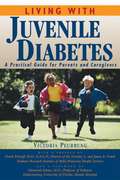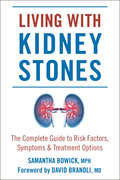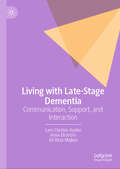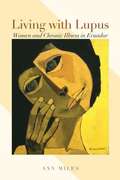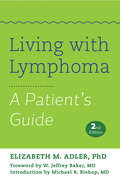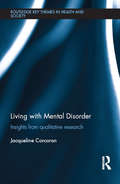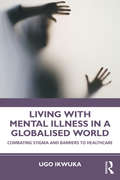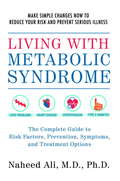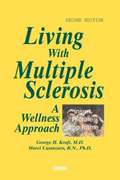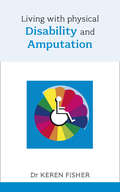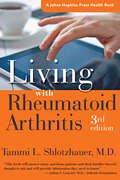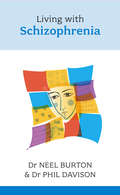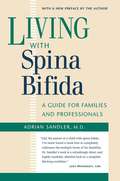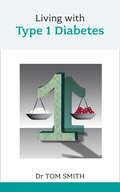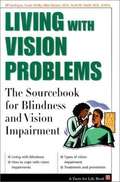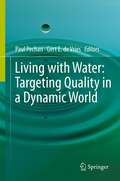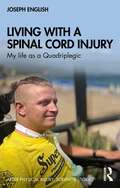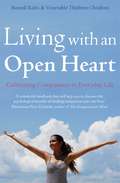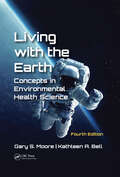- Table View
- List View
Living with Hearing Loss
by Marcia B. Dugan Howard E. StonePeople who are hard of hearing and their friends and relatives now can learn all they need to know about hearing loss in this easy to read guide. Newly updated and revised, Living with Hearing Loss takes the reader from A to Z on the kinds and causes of hearing loss and its common early signs. Written by Marcia B. Dugan, past president of Self Help for Hard of Hearing People (SHHH), this straightforward book provides thorough information on seeking professional evaluations and complete descriptions of hearing aids and other assistive technologies. Enhanced sections on the potential of cochlear implants and dealing with tinnitus distinguishes this very useful handbook. Readers also can take advantage of updated information on relevant Internet sites and a new list of resources on dealing with hearing loss. Living with Hearing Loss also suggests strategies for everyday situations and times of emergency. Chapters on speechreading, oral interpreters, assertive communication, and other tips for improving communication can enable people with hearing loss to make changes at work, home, and while traveling to cope with most situations. It can raise significantly the quality of the lives of hard of hearing people while also helping them to avoid dependency upon others.
Living with Hereditary Cancer Risk: What You and Your Family Need to Know (A Johns Hopkins Press Health Book)
by Sue Friedman Kathy Steligo Allison W. KurianThe most comprehensive guide available on hereditary cancers, from understanding risk, prevention, and genetic counseling and testing to treatment, quality of life, and more.Up to 10 percent of cancers are caused by inherited mutations in specific genes. Finding out that you or your loved ones may be at increased risk of developing cancer because of a genetic mutation raises a lot of questions: Is cancer inevitable? Is there anything I should do differently in my life? Will my children also be at higher risk of cancer? Should I have preemptive treatments or surgery? This comprehensive guide provides answers to these questions and more. Written by three passionate patient advocates, this book is a compilation of the trusted information and support provided for more than two decades by Facing Our Risk of Cancer Empowered (FORCE), the de facto voice of the hereditary cancer community. Combining the latest scientific research with national guidelines, expert advice, and compelling patient stories, the book offers previvors (those who have a mutation but have never been diagnosed), survivors, and their families the guidance they need to face the unique physical and emotional challenges of living in a high-risk body.An ideal resource for genetic counselors, physicians, nurses, advocates, and others who support and care for the hereditary cancer community, Living with Hereditary Cancer Risk also provides coverage of • signs of inherited cancer risk in a family;• the value of genetic counseling and testing;• mutations in BRCA, Lynch Syndrome, and other genes that elevate cancer risk; • risk-reducing strategies; • traditional treatments and newer personalized approaches, including immunotherapies and PARP inhibitors; • nationally recommended guidelines for prevention, early detection, and treatment; • insurance coverage and discrimination protections; and• coping with sexual health, fertility, menopause, and other quality of life issues.
Living with IBS
by Nuno FerreiraIf you have Irritable Bowel Syndrome (IBS), you're not alone - it affects up to 20 per cent of the population in the Western world. In fact, it is so widespread that some specialists have called it 'the common cold of the gastrointestinal illnesses'. Medical treatments are only moderately effective, and many experts now agree that the focus should be on improving quality of life for people with this condition. Living With IBS uses the principles of Acceptance and Commitment Therapy (ACT) to help people overcome the distress associated with IBS and to live a more vital and fulfilling life.
Living with Juvenile Diabetes: A Practical Guide for Parents and Caregivers
by Victoria PeurrungIn Living with Juvenile Diabetes, author Victoria Peurrung, mother to two children with juvenile diabetes, provides answers and coping strategies for families everywhere who are struggling with juvenile diabetes. Living with Juvenile Diabetes offers practical hints and ideas for parents, teachers, coaches and other caregivers who deal with children with Type 1 diabetes, as well as how to help their child deal with the condition on a daily basis. Read Living with Juvenile Diabetes for: * The latest facts and treatments * How to deal with the emotional roller-coaster * Step-by-step instructions for preparing insulin and giving injections * Tips on exercise and nutrition * Recipes, supplies, research trends and much more!
Living with Kidney Stones: Complete Guide to Risk Factors, Symptoms & Treatment Options (Living with)
by Samantha BowickTHE MOST UP-TO-DATE INFORMATION ON TREATING KIDNEY STONESLiving with Kidney Stones is a health resource for anyone who has ever suffered with the pain of kidney stones.One in 10 individuals will suffer from kidney stones at some point in their life. Composed of hard, painful mineral deposits forming inside the kidneys, these stones are both crippling and potentially chronic. Thankfully, patients can take action to reduce their chances of developing or redeveloping kidney stones by following a good diet, observing proper self-care, and adopting a comprehensive wellness plan.To that end, Living with Kidney Stones offers the most up-to-date information on this illness, paired with heartfelt insight from an actual kidney stone sufferer.Living with Kidney Stones also includes:• Easy-to-understand information on types and causes of kidney stones• The latest information on kidney stone testing• Traditional and alternative options for a broad, full-body approach to wellness• Guidance on self-care techniques for patients, families and caregivers• Valuable medical and community resources for kidney stone sufferersLearning to manage your risk factors for kidney stones can seem overwhelming, but by taking everything one day at a time and making sure you&’re provided with the care and support you need, you can minimize your risk while maximizing your quality of life. Don&’t just live with kidney stones—live well.
Living with Late-Stage Dementia: Communication, Support, and Interaction
by Lars-Christer Hydén Anna Ekström Ali Reza MajlesiThis book investigates how people living with late-stage dementia can engage in communication and social interaction. Based on empirical research, it explores the remaining communicative resources of people living with cognitive impairment (e.g., intercorporeal interaction, bodily gestures, gaze), presenting the agency of the person with dementia as an integral part of their relations with others. The book provides a comprehensive theoretical framework for analyzing, describing, and understanding communication in late-stage dementia, and explores the use of video ethnography to record and analyze non-verbal, bodily interaction. The authors skilfully bring together findings from their examinations of everyday interactions involving individuals living with late-stage dementia in nursing facilities, introducing the readers to the innovative theoretical and methodological approaches that undergird the fine-grained analyses at the heart of the book. The rich and nuanced case studies collected encompass embodied directives, habitual actions and objects, physical settings, assisted eating, and much more. An invaluable resource for graduate students and researchers at all levels in the fields of psychology, psychotherapy, social work, nursing, gerontology, and related disciplines, this volume makes an unparalleled contribution to current dementia research across the social sciences.
Living with Lupus: Women and Chronic Illness in Ecuador
by Ann MilesOnce associated only with the wealthy and privileged in Latin America, lifelong illnesses are now emerging among a wider cross section of the population as an unfortunate consequence of growing urbanization and increased life expectancy. One of these diseases is the chronic autoimmune disorder lupus erythematosus. Difficult to diagnose and harder still to effectively manage, lupus challenges the very foundations of women's lives, their real and imagined futures, and their carefully constructed gendered identities. While the illness is validated by medical science, it is poorly understood by women, their families, and their communities, which creates multiple tensions as women attempt to make sense of an unpredictable, expensive, and culturally suspect medically managed illness. Living with Lupus vividly chronicles the struggles of Ecuadorian women as they come to terms with the experience of debilitating chronic illness. Drawing on years of ethnographic research, Ann Miles sensitively portrays the experiences and stories of Ecuadorian women who suffer with the intractable and stigmatizing disease. She uses in-depth case histories, rich in ethnographic detail, to explore not only how chronic illness can tear at the seams of women's precarious lives, but also how meanings are reconfigured when a biomedical illness category moves across a cultural landscape. One of the few books that deals with the meanings and experiences of chronic illness in the developing world, Living with Lupus contributes to our understanding of a significant global health transition. Once associated only with the wealthy and privileged in Latin America, lifelong illnesses are now emerging among a wider cross section of the population as an unfortunate consequence of growing urbanization and increased life expectancy. One of these diseases is the chronic autoimmune disorder lupus erythematosus. Difficult to diagnose and harder still to effectively manage, lupus challenges the very foundations of women's lives, their real and imagined futures, and their carefully constructed gendered identities. While the illness is validated by medical science, it is poorly understood by women, their families, and their communities, which creates multiple tensions as women attempt to make sense of an unpredictable, expensive, and culturally suspect medically managed illness. Living with Lupus vividly chronicles the struggles of Ecuadorian women as they come to terms with the experience of debilitating chronic illness. Drawing on years of ethnographic research, Ann Miles sensitively portrays the experiences and stories of Ecuadorian women who suffer with the intractable and stigmatizing disease. She uses in-depth case histories, rich in ethnographic detail, to explore not only how chronic illness can tear at the seams of women's precarious lives, but also how meanings are reconfigured when a biomedical illness category moves across a cultural landscape. One of the few books that deals with the meanings and experiences of chronic illness in the developing world, Living with Lupus contributes to our understanding of a significant global health transition.
Living with Lymphoma: A Patient's Guide
by Elizabeth M. AdlerThe second edition of this award-winning guide reflects profound shifts in the lymphoma landscape, including new treatments that are extending survival.Winner, American Medical Writers Association Medical Book AwardWhen neurobiologist Elizabeth M. Adler was diagnosed with non-Hodgkin lymphoma almost twenty years ago, she learned everything she could about the disease, both to cope with the emotional stress of her diagnosis and to make the best possible decisions for her treatment. In Living with Lymphoma, she combines her scientific expertise and personal knowledge with a desire to help other people who have lymphoma manage this complex and often baffling disease.With the availability of more effective treatment regimens, many people with lymphoma are living longer; in fact, there are more than 700,000 lymphoma survivors in the United States alone. Given this change in the lymphoma landscape, the second edition of this book places a greater emphasis on survivorship. The new edition includes the latest information on lymphoma diagnosis, treatment, and incidence and describes the most recent update to the WHO system of lymphoma classification and staging. Adler discusses new targeted therapies like ibrutinib and idelalisib and describes how other treatments, including radiation therapy and stem cell transplants, have been modified while others have been discontinued. She also addresses new developments, such as the possible role of lack of sunlight and vitamin D in the pathogenesis of lymphoma, and the use of medical marijuana. The book includes suggestions for further reading, including the latest material available online.
Living with Mental Disorder: Insights from Qualitative Research (Routledge Key Themes in Health and Society)
by Jacqueline CorcoranThis evidence-based text puts a human face on mental disorders, illuminating the lived experience of people with mental health difficulties and their caregivers. Systematically reviewing the qualitative research conducted on living with a mental disorder, this text coalesces a large body of knowledge and centers on those disorders that have sufficient qualitative research to synthesize, including attention-deficit/hyperactivity disorder, autism, intellectual disabilities, mood disorders, schizophrenia and dementia. Supported by numerous quotes, the text explores the perspective of those suffering with a mental disorder and their caregivers, discovering their experience of burden, their understanding of and the meaning they give to their disorder, the strengths and coping they have used to manage, as well as their interactions with the formal treatment system and the use of medication. This book will be of immense value to students, practitioners, and academics that support, study, and treat people in mental distress and their families.
Living with Mental Illness in a Globalised World: Combating Stigma and Barriers to Healthcare
by Ugo IkwukaLiving with Mental Illness in a Globalised World systematically examines the manifold contributions to the burdens of living with mental illness in a developing and globalised world. It explores the stigma of mental illness, the burden of which compares to the symptoms of and is sometimes considered more disabling than the illness itself. The book starts by reviewing the socio-psychological and cultural processes that contribute to stigma and providing evidence-based interventions to combat it. Chapters critically investigate the ideological and instrumental barriers to mental healthcare and establish that determining the conceptualisations of mental illness helps to unravel the reasons for the underutilisation of mental health services. A compelling case is made for a complementary healthcare model and bottom-up approach that is sensitive to the spiritual and cultural needs of the people. The text’s specific examination of mental healthcare in African countries makes it a timely piece for assisting mental health professionals in understanding the inequities in care that Black Asian and Minority Ethnic groups face and how to improve mental healthcare and delivery to these groups.
Living with Metabolic Syndrome
by Naheed AliTHE FIRST TRULY COMPREHENSIVE RESOURCE FOR METABOLIC SYNDROME PATIENTSAffecting well over 50 million Americans, the series of conditions known as metabolic syndrome has reached epidemic proportions. Found in patients where increased blood pressure, high blood sugar level, excess body fat, and abnormal cholesterol level occur together, metabolic syndrome increases the risk of heart disease, stroke and diabetes. With so many conditions working together, and no set list of identifiable symptoms, the best defense against metabolic syndrome is information--understanding the need for proper diet, exercise, and wellness checks. So long as patients at risk of developing metabolic syndrome understand their risk factors, they can work to prevent the syndrome and restore their good health.Incorporating information from all the latest research and treatment options, Living with Metabolic Syndrome is the breakthrough guide to understanding this ever-growing health problem. This comprehensive manual takes advantage of new findings from both clinical and physician studies while providing guidance in clear, authoritative language. Touching on every aspect of metabolic syndrome, including: risk factors and possible symptoms; doctor's visits, including choosing a specialist; and dealing with the emotional/psychological strain of long-term illness, Living with Metabolic Syndrome offers powerful techniques and real-world advice that sufferers can immediately relate to.Living with Metabolic Syndrome covers:* Detailed information on the risk factors for metabolic syndrome, including diet, lifestyle and heredity* The variety of possible symptoms, such as fatigue and low appetite, which can accompany the syndrome* Treatment options, both medical and holistic, including the latest research discoveries and updatesThe essential steps after receiving a diagnosis of metabolic syndrome, including a quick-start 10-step checklist* The role that each doctor and specialist will play in your diagnosis and treatment regimenProviding not only knowledge and hope, but new and practical ways of confronting and living with the syndrome, Living with Metabolic Syndrome lets you reclaim your health, your energy, and your life.From the Trade Paperback edition.
Living with Multiple Sclerosis: A Wellness Approach
by Marci Catanzaro George H. KraftThis brand-new second edition incorporates many of the most recent developments in MS management and adds new material that reflects the explosion of new management strategies for MS and its new status as a treatable disease, and new concepts of "wellness" that are of general application as well as useful in managing chronic disease. With a broad base of topics, this guide systematically shows you how to live optimally with this neurologic disease. It offers advice on how to take control of your life in order to maximize your health. The book not only addresses the diverse choices for wellness, but also pinpoints the ramifications of various behaviors and activities. You'll find answers to the most commonly asked questions about living with multiple sclerosis, including causes and course symptom management wellness management emotional health disease treatments alternative therapies and social aspects. The authors suggest some avenues for optimizing your health through exercise, nutrition, and stress management. This excellent resource provides all of the guidelines you need to start developing your own individualized wellness program.
Living with Physical Disability and Amputation
by Keren FisherAccording to the Department of Health, there are 8.7 million physically disabled people in the UK. Of these, some 460,000 people have spinal cord injuries and/or amputations. Acquiring a disability brings specific problems, not just in terms of confidence, self-esteem, and adapting to a new physical reality, but of the recognized medical phenomenon of limb disconnection, which involves a mismatch between the brain's actual representation of the body shape and its physical appearance. There is plenty of mythology around 'phantom limbs' and similar, but this book takes an evidence-based look at the reality, and uses cognitive behavioural therapy and other methods to deal with it.
Living with Rheumatoid Arthritis (A Johns Hopkins Press Health Book)
by Tammi L. ShlotzhauerThe trusted guide that has helped thousands of people cope with this painful condition—now thoroughly updated and revised.Rheumatoid arthritis is an autoimmune disease in which inflammation plays a major role in causing joint problems. Warmth and swelling in the joints, along with significant stiffness and pain, can make daily life difficult. Many people with rheumatoid arthritis also experience fatigue, low-grade fever, loss of appetite, depression, and muscle aches.In this, the third edition of Living with Rheumatoid Arthritis, Tammi L. Shlotzhauer describes new findings about causes and treatments, including • New research on risk factors and triggers, including pathologic bacteria in the digestive tract, smoking, and exposure to pollutants and chemicals• Lifestyle and diet modifications that can help avoid potential triggers • How stress contributes to inflammation and other symptoms • Information about new biologic disease-modifying drugs • Promising research on biomarkers that may generate a personalized approach to treatment • Remarkable gains in reducing disability, hospitalizations, and surgeriesIn addition to explaining the causes, symptoms, and treatment options for people who have rheumatoid arthritis, Dr. Shlotzhauer offers practical strategies for coping with the pain, fatigue, and emotional toll of a chronic illness. She provides new information on associated diseases such as osteoporosis, tips for finding safe and reliable information online, and information on how to get an accurate diagnosis.
Living with Schizophrenia
by Neel BurtonThere is a perception that schizophrenia is both uncommon and impossible to treat. In fact, it affects about 650,000 people in the UK, 2.2 million in the US, and some 50 million globally; and, the treatment success rate with today's medication and therapy can be high.It affects men and women in equal proportions, but often appears earlier in men. Symptoms are often terrifying and include visual and auditory hallucinations and acute paranoia, which may leave sufferers withdrawn, and incomprehensible or frightening to others.Living with Schizophrenia aims to fill a gaping hole in the market for information and self-help guides by addressing the needs of people with schizophrenia and their carers, relatives, and friends. Topics include:Authoritative description of what schizophrenia is and isn'tInformation and support for families and friends; how they can helpDiagnosisPhysical treatmentsPsychological treatments (talking therapies)Social interventionsFurther help
Living with Spina Bifida
by Adrian SandlerIt is the most common complex birth defect. Spina bifida affects approximately one out of every 1,000 children born in the United States. In this comprehensive guide, Dr. Adrian Sandler offers a wealth of useful information on the medical, developmental, and psychological aspects of this condition. Accurate, accessible, and up-to-date, Living with Spina Bifida is written especially for families and professionals who care for children, adolescents, and adults with spina bifida. This edition contains a new preface by the author, addressing recent developments in research and treatment, as well as an updated list of spina bifida associations.
Living with Type 1 Diabetes
by Tom SmithDiabetes is on the increase in all age groups and is described by the World Health Organisation as an epidemic. The good news is that effective control can greatly improve life expectancy, as well as reducing the risk of complications such as cardiovascular disease, stroke, kidney disease and blindness. This book explains how to tackle type one diabetes in adults and teenagers; it also looks at type two diabetes and explains why the dividing line between types one and two is not always easy to draw. Topics include: Late-onset type one diabetes; Organising your insulin; Pumps and transplants; Type two diabetes and the metabolic syndrome; Why so many more people with type two diabetes now need insulin for control; Managing type two diabetes - keeping the glucose levels down; Diet and weight control; Why you mustn't smoke - and how to stop if you do.
Living with Type 1 Diabetes
by Tom SmithDiabetes is on the increase in all age groups and is described by the World Health Organisation as an epidemic. The good news is that effective control can greatly improve life expectancy, as well as reducing the risk of complications such as cardiovascular disease, stroke, kidney disease and blindness. This book explains how to tackle type one diabetes in adults and teenagers; it also looks at type two diabetes and explains why the dividing line between types one and two is not always easy to draw. Topics include: Late-onset type one diabetes; Organising your insulin; Pumps and transplants; Type two diabetes and the metabolic syndrome; Why so many more people with type two diabetes now need insulin for control; Managing type two diabetes - keeping the glucose levels down; Diet and weight control; Why you mustn't smoke - and how to stop if you do.
Living with Vision Problems: The Sourcebook for Blindness and Vision Impairment
by Jill Sardegna Susan Shelly Allan Rutzen Scott M. SteidlMillions of Americans have a significant level of vision impairment. This revised edition of Living with Vision Problems is designed to provide students with helpful information such as: how to cope, causes and types of vision impairments, preventions, treatments and even LASIK procedures. It is an extensive sourcebook for all topics, including medical, concerning blindness.
Living with Water
by Paul Pechan Gert E. de VriesThe factors affecting water quality are many: The increasing buying power and health concerns of the world population contribute to the creation of new products whose production and disposal lead to the release of chemicals harmful to the environment; the ever-growing world population requires a steady food supply, which increases the pressure to use even more chemicals to control various crop pests; and due to climate change, head waters, rivers, and oceans are becoming increasingly warmer, acidic, and eutrophic as the result of carbod dioxide overload. Using specific examples, Water Quality and Resource Management will address the many challenges of providing clean water to the growing world population. It will also discuss the new technologies that are being developed, for example, to treat and reuse waste waters, and the innovative monitoring approaches that help scientists to assess water quality risks. Such risk assessments are urgently needed to help draft legislations and allow enforcement to ensure accessability to quality water for all. The structure of the book will be the following: Each chapter will provide information about a specific water environment and the challenges it faces. This will be followed by discussion of the pollution effects and actions taken to redress the situation. Finally, future trends will be discussed.
Living with a Black Dog
by Matthew Johnstone Ainsley JohnstoneAs beautifully illustrated as it is touching, this second book from Matthew Johnstone, author of I Had a Black Dog, is written for those who care for those suffering from depression - friends, family members, colleagues, and even therapists. Using wonderful illustrations and the image of Churchill's infamous 'black dog', Matthew and his wife Ainsley offer a moving, inspirational and often humorous portrait of life with depression - not only for those suffering from it themselves, but for those close to them. Living with a Black Dog speaks directly to the carer and offers practical and sometimes tongue-in-cheek tips on helping the depression sufferer, such as 'Socks have little do with mental health. If people could just "snap out of it" they would.' and 'Encourage any form of regular exercise. Fitness robs the Dog of its power'. Based on their own experiences, Matthew and his wife Ainsley treat the subject of depression sympathetically, hopefully and, most importantly, humorously.
Living with a Spinal Cord Injury: My life as a Quadriplegic
by Joseph EnglishJoseph English was living his best life when a car accident changed everything. He suffered life changing injuries, and the doctors told him there was no chance of recovery. Facing life as a quadriplegic, Joe lost his business, his romantic partner, and, for a while, his will to carry on. His story, told with extensive contributions from his family and friends, charts his journey from being dead at the roadside to finding something to live for as he recounts his progress from injury to survival. With absolute candour, Joe tells the whole story of his accident, his rehabilitation, and his recovery. Full of advice and suggestions from professionals in the rehabilitation journey, this book is remarkably frank about the struggles Joe has endured, and the times when he felt as if life wasn’t worth living. It addresses all the most difficult issues around life after paralysis, including loss of identity and letting go of the past, as well as providing practical information on topics such as assistive technology, financial claims and legal support. It also outlines the various roles of those in the rehabilitation team. His doctors and specialist practitioners give their unique perspectives into their processes and procedures, helping to demystify them, while Joe’s family and friends ask the kinds of questions readers will be asking too, making this an invaluable guide to what to expect for anyone going through a similar experience. The book shows – by lived example – that there is always more to live for. It is essential reading for those with paraplegia, quadriplegia and other spinal injuries, and their families, friends and care-givers. It is also valuable for neuropsychologists, neurologists and other rehabilitation therapists, as well as students in medicine, nursing, allied health and neuropsychology.
Living with an Open Heart: How to Cultivate Compassion in Everyday Life
by Thubten Chodron Russell KoltsLiving with an Open Heart contains brief readings which blend Buddhist and western psychology. It thoughtfully presents ideas and techniques drawn from Buddhism, western psychological approaches, as well as the authors' personal experiences in working to develop compassion in their own lives and in their work with others. Designed to be easy to dip into, this fascinating book is organised into brief chapters to include discussions, reflections and contemplations, personal stories, and specific techniques for deepening compassion. Each chapter provides fuel for thought and contemplation as the reader goes through his or her day, inspiring their motivation to be compassionate, helping them to understand compassion, and giving them specific methods for applying it in their lives.
Living with the Earth, Fourth Edition: Concepts in Environmental Health Science
by Gary S. Moore Kathleen A. BellShelving Guide; Environmental ScienceThis is a groundbreaking and innovative book now in its fourth edition. The first edition won the CHOICE award for outstanding Academic Book while editions two and three became bestsellers on their own right. This fourth edition is packed with new updates on current world events associated with environmental issues and related health concerns. The author maintains traditional concepts and merges them with new and controversial issues. The book has been revised to include up-to-date topics with and a revised Web site with updated links.So what Coverage of emergency preparedness for environmental health practitioners Discussion of population dynamics especially with regard to overpopulation and underpopulation around the world and their respective influences on social, economic, and environmental concerns. The mechanisms of environmental disease, emphasizing genetic disease and its role in developmental disorders and cancer. Human behaviors and pollution are presented along with respect to their roles in cancer risk. The ever increasing issues surrounding emerging and re-emerging diseases around the earth and the introduction of an increasing number of emerging diseases. The growing problems of asthma and other health effects associated with air pollution. An exploration of the mechanisms of toxicity with special reference to the immune system and endocrine disruption. The ongoing issues of the creation and disposal of hazardous waste along with the controversies surrounding disposal are presented. The issues and benefits of recycling are explored. The use of HACCP in assuring food quality, food safety issues, and the Food Quality Protection Act are discussed. Numerous technical illustrations, charts, graphs, and photographs are included What on the Web? Test bank and study questions giving a complete review of the concepts covered. Search tools for online journals and databases covering useful, up-to-date information in health and environmental topics Subject specific links by chapter as well as Federal, state, and organization sites with relevant information Downloadable PowerPoint files for each Chapter providing the instructor with ready-made presentation materials that can be modified as needed. Downloadable and printable test questions and answers for each chapter available to instructors
Llibre de la Marato 2020: Aquesta Marató toca a tothom
by Varios autoresEl llibre de La Marató d'enguany, esta dedicat a recudar fons pel a la recerca de la Covid-19. Sobren les paraules, o no les sabem trobar. S'han amagat darrere les nostres mirades i els nostres sentiments. La Covid-19 se'ns ha ficat entre els plecs del dia a dia a tots, i tots hem sigut actors i espectadors d'una situació que no podíem imaginar ni en el pitjor dels malsons. La majoria hem restat a casa, con nats molt temps. Però n'hi ha que han plantat cara al virus, que l'han buscat pels racons i l'han perpetuat en una imatge. Són els fotògrafs i els fotoperiodistes: ells han entomat el repte de mirar als ulls els qui han patit, els qui hem patit aquesta ofensa a la nostra salut, a la nostra convivència, a molts dels nostres somnis. Anna Surinyach, Cristina García Rodero, Donna Ferrato, Chema Madoz, Emilio Morenatti, Gervasio Sánchez, Isabel Muñoz Vilallonga, Jordi Borràs Abelló, Lua Ribeira, Noemí Elias, Ofelia de Pablo i Javier Zurita, Oriol Alamany Sesé, Ricard García-Vilanova, Samuel Aranda, Susana Vera, Tomeu Coll i Xavier Bertral omplen aquest llibre de tot allò que no poden expressar les paraules: l'omplen de la cruesa, la tendresa i la solidaritat que envolta aquesta inesperada situació, quereclama de tots nosaltres un cop de mà (o de colze), perquè ens necessitem, els uns als altres, més que mai. No els calen paraules, tot i que els les hem demanat. Com també els les hem demanat a dos experts que han treballat per guarir els nostres cossos i les nostres ments: el doctor epidemiòleg Antoni Trilla i la doctora en psicología Jenny Moix ens expliquen la seva feina i la seva vida durant la pandèmia. La Marató, aquest any més que mai, és al costat de tots, i, potser més que mai, tots haurem d'estar al costat de La Marató.
